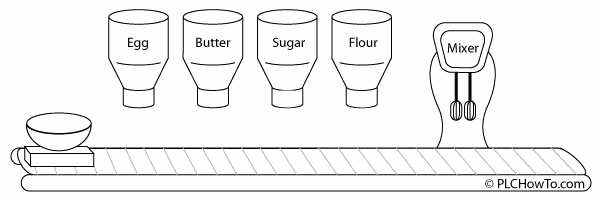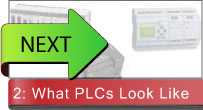![]()
A Programmable Logic Controller (PLC) is a specialized computer designed to interact with machinery. They are ideally suited for performing repetitive, predictable operations. Typically, PLCs are designed to endure harsh environments, and perform instructions within tight time constraints.
Interacting with machinery
The PLC is the brain of an automated system, while it’s inputs and outputs are the neurological system, connecting sensors and action oriented parts to the brain.
Inputs: Tell the PLC about it’s environment. They connect to temperature sensors, position detectors, limit switches etc. Gathering environmental data from inputs, PLCs decide what actions to take.
Outputs: Tell things what to do. Outputs may instruct motors to go to a position, a valve to open or a door to lock.
Connections to Other Electronics: Many PLCs include communication ports including USB, Ethernet, RS485 and RS232. These allow the PLC to talk to other PLCs, PCs, barcode scanners, Operator Panels etc.

Things a PLC may do to run the cookie factory above:
Inputs: Connected to temperature sensors in Egg and Butter chutes, Position detectors monitoring when the bowl has reached station, scale under bowl confirming correct amount of ingredients have fallen from chutes.
Outputs: Connected to motor that moves conveyor belt, refrigeration unit in Egg chute, warming unit in Butter chute, actuator that causes chutes to open/close, and motors that drive the mixer.
PLC: Using the temperature inputs, it decides when to turn on refrigeration/warming units. Position detectors and scale under bowl are used to determine when to advance the conveyor, and when to lower and turn on the mixer. Along with doing the routine, the PLC will provide error warnings when things go wrong, so an operator can investigate.
Connections to Other Electronics: An operator panel could show the operator current status of the cookie batch, as any errors that have occurred. The PLC may also be connected to the building’s Ethernet system, so a manager can monitor progress from a remote office.
Reliability: PLCs often control highly critical devices, and as a result they are built to be reliable.
Harsh Enviroments: They are designed to endure temperature extremes and vibration.
Real Time: They don’t have the luxury of crashing occasionally like PCs do. Also, they must perform operations at precise times(something that isn’t standard with many PC operating systems).


Leave a Reply